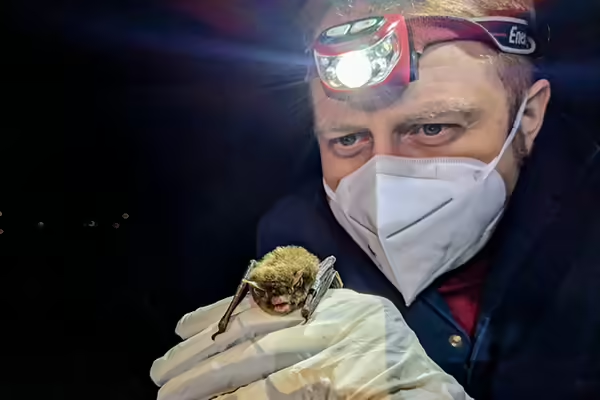
URBANA, Ill. — How do wildlife researchers know when an endangered population is sick? They can detect infectious microbes in animal waste, but the presence of a microbe doesn’t always equate to impactful symptomatic infections. In a new study, University of Illinois Urbana-Champaign researchers used advanced molecular tools to survey the health status of endangered Indiana bats, identifying microbiome changes resulting from parasitic infections.
“In conservation medicine, sick patients will rarely schedule a follow-up visit, so tracking the impact of a disease in real time is a challenge. We take a big picture view of microbial interactions at the population level to infer the burden of a disease over time from a snapshot,” said lead study author Andrew Bennett, a postdoctoral researcher in the Department of Natural Resources and Environmental Sciences, part of the College of Agricultural, Consumer and Environmental Sciences at Illinois.
Bennett and his colleagues temporarily captured Indiana bats at the entrance of a Missouri hibernation site, gently holding them long enough to collect a single fecal sample. They brought these samples back to a lab where they extracted DNA and identified the presence of gut microbes and parasites using a process called multiplex metabarcoding. They also documented changes in the makeup of the gut microbiome that corresponded with the amount of parasites present.
What they found was Eimeria, a protozoan parasite that hangs out in the gut and causes coccidiosis, a disease that leads to economic losses in many livestock animals. Bennett says Eimeria can be present at low levels in the gut without causing problems, but research in other animals has shown that stress can cause Eimeria to proliferate, invading and damaging gut tissue and leading to secondary bacterial infections.
The analysis revealed that bats with high loads of Eimeria had a corresponding proliferation of Clostridium bacteria, particularly those associated with severe tissue damage in other species.
Study co-author Joy O’Keefe, associate professor in NRES and wildlife Extension specialist, says they can still only guess at symptoms infected bats might be experiencing and whether Eimeria infection significantly affects survival or population size.
Read the full article from the College of ACES.
University of Illinois Extension develops educational programs, extends knowledge, and builds partnerships to support people, communities, and their environments as part of the state's land-grant institution. Extension serves as the leading public outreach effort for University of Illinois Urbana-Champaign and the College of Agricultural, Consumer and Environmental Sciences in all 102 Illinois counties through a network of 27 multi-county units and over 700 staff statewide. Extension’s mission is responsive to eight strategic priorities — community, economy, environment, food and agriculture, health, partnerships, technology and discovery, and workforce excellence — that are served through six program areas — 4-H youth development, agriculture and agribusiness, community and economic development, family and consumer science, integrated health disparities, and natural resources, environment, and energy.